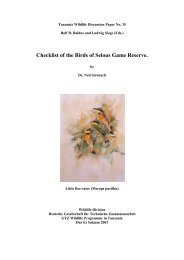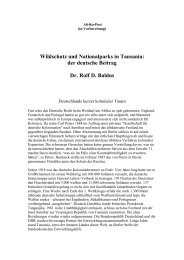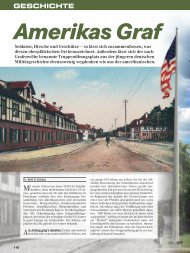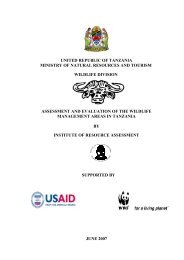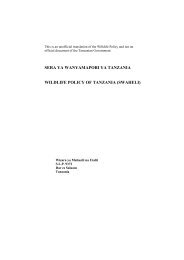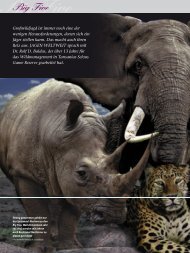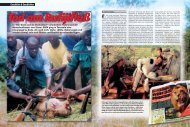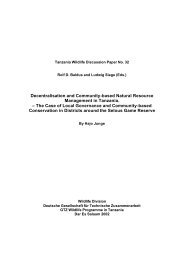African Indaba Articles - wildlife-baldus.com
African Indaba Articles - wildlife-baldus.com
African Indaba Articles - wildlife-baldus.com
Create successful ePaper yourself
Turn your PDF publications into a flip-book with our unique Google optimized e-Paper software.
Tourist Hunting: How Tanzania Can Benefit From SADC BestPracticesBy Simon Milledge, TRAFFIC East/Southern AfricaSport hunting in the SADC regionThe sport hunting industry in the SADC region is massive. During the late 1990s, direct annual trophyhunting revenues reached USD29.9 million in Tanzania, USD28.4 million in South Africa, USD23.9 million inZimbabwe, USD12.6 million in Botswana and USD11.5 million in Namibia. Further, it is a growing industry inmost countries, since well-managed sport hunting can be one of the optimal land use options, especially inmarginal habitats. As a result, sport hunting is <strong>com</strong>monly the backbone to <strong>com</strong>munity-based naturalresource management in <strong>com</strong>munal lands, especially in Botswana, Namibia and Zimbabwe, and brings<strong>wildlife</strong> management to new areas. Southern Africa currently offers some 420,000km 2 of <strong>com</strong>munal land and188,000km 2 of <strong>com</strong>mercial land for sport hunting. Wildlife numbers outside of protected areas in Botswana,Namibia and Zimbabwe <strong>com</strong>munal and private lands are increasing, due mainly to the value now placed onthe lucrative sport hunting resource. In general, sport hunting is a high-return, low-impact <strong>wildlife</strong> use whichcan <strong>com</strong>pliment a host of other activities, for example <strong>wildlife</strong> viewing safaris and trade in hides, horns andmeat. It is also recognized as a valid <strong>wildlife</strong> management tool under certain circumstances, for example inaddressing human-<strong>wildlife</strong> conflicts or enhancing species’ population performance.Although not hunted in large numbers, the ‘big five’ species – lion, leopard, rhino, elephant and buffalo –are responsible for generating the largest proportion of in<strong>com</strong>e. South Africa is the only country which offersall five, but other countries offer individual species of better trophy quality. For example, Tanzania is knownfor its lion, leopard and buffalo.Further growth and development of the industry depends upon optimal trophy quality, species diversityand professionalism of the services officered. However, the growth of the industry currently exceeds thecapacity to manage it well throughout the region. Overall successes of the industry are marred by thecontinued existence of unsustainable management practices, especially in relation to quota setting andhunting concessions allocations. The lucrative nature of the industry and potential for abuse and corruptionstill affects the industry and incentives are required to improve such management practices. Further, thedemand for sport hunting in SADC currently outweighs the supply, and poor ethical practices have be<strong>com</strong>ean issue resulting from intense <strong>com</strong>petition. It is also be<strong>com</strong>ing increasingly important that the managementstructures (private, governmental or non-governmental) implement socially responsible policies.Tourist hunting in TanzaniaThe tourist hunting industry in Tanzania is one of the most lucrative within the SADC region, due to thecountries reputation for trophy quality and unspoiled hunting areas. Total off-take in terms of animals huntedis negligible when <strong>com</strong>pared to total revenues generated. Wildlife policy incorporates tourist hunting and therevenues it raises as the economic backbone to the country’s <strong>com</strong>munity-based <strong>wildlife</strong> managementaspirations. Although contributing significantly to <strong>com</strong>munity livelihood in some areas (e.g. FriedkinConservation Fund and Cullman & Hurt Community Programs, and in areas surrounding the Selous GameReserve), the potential for harnessing the potential of tourist hunting for stimulating <strong>com</strong>munity <strong>wildlife</strong>management has gone largely untapped. This is mainly due to a lack of legislative change to adequatelyreflect <strong>wildlife</strong> policy. In addition, management strategies as outlined in well-developed Tourist HuntingPolicies remain largely unimplemented, suggesting a lack of motivation and will on the part of governmentand private sector. Legislative reform, and increased impetus to affect implementation of managementstrategies needs to occur as a matter of priority so that the overall viability and integrity of the tourist huntingsector is safeguarded.More detailed information on the Tanzania tourist hunting industry is adequately described in the sameissue by Baldus and Cauldwell. This article serves to draw upon the experience gained from an assessment 1of the sport hunting industry in five SADC countries (Botswana, Namibia, South Africa, Tanzania andZimbabwe). The following are some of the key re<strong>com</strong>mendations specific to Tanzania.38



